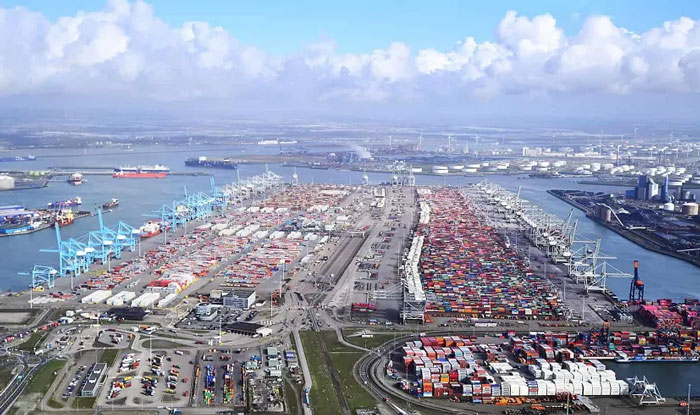

The freight rate of the eastern United States is lower than that of the western United States, and the port of the eastern United States is about to face a port strike
This week, shipping companies cut flights, especially on the US-West route, and the threat of strikes in the East led to the diversion of goods from the East to the West, and freight rates quickly approached. Market rate volatility is high and expected to continue. Eastern United States may strike in October! American companies, logistics industry worry about impact on the supply chain.
Large freight forwarding companies pointed out that this week shipping companies began to implement reduction measures, especially the reduction of the US-West route significantly, coupled with the threat of strikes in the East of the United States that may occur on October 1, some of the goods originally planned to be shipped to the East of the United States have been diverted to the West of the United States, resulting in the rapid approach of freight rates between the United States and the East of the United States. Maersk's official website shows that the freight rate for the East Savannah has dropped to $4,900 per large box, lower than the $5,000 on the West Line, and the market freight rate has fluctuated sharply and is predicted to continue to be volatile.
At present, the actual freight rate of the United States East route is generally between 5900 and 6000 US dollars, while the United States West is in the range of 4300 to 4800 US dollars. Non-alliance ships offer lower prices because they have fewer customers; Although alliance ships are priced high, through the matching mechanism, they can eventually provide freight rates comparable to non-alliance ships, so as to cope with the current situation of more ships and less cargo and prevent the loss of cargo.
Maersk, as the representative of the online offer, has a flexible pricing strategy and currently offers $5,300 for New York. Unlike in the past, freight forwarders can provide freight rates immediately. Now, due to daily price changes, the quotation can only be given after online confirmation.
In the domestic market, the freight rate is still lower than the Taiwan market, the freight rate from Shanghai, Ningbo to the West of the United States is about 4,200 US dollars, and the southern region can reach 4,500 US dollars. A shipping company senior revealed that there is a customer in Ningbo about one hundred large cabinets to go out, but the company believes that the current market rate is still high, and the market rate is bearish, said to wait for the rate to drop sharply to the level of no loss of money before shipping.
Container shipping companies are scheduled to raise freight rates on September 15, but most freight forwarders are pessimistic about this and believe that the increase will not be realized. However, there are also views that, given that some flights in the West of the United States are nearly full, there may be a chance of an increase next week. However, given that the price hike attempt in mid-August brought only a brief market recovery, the industry has expressed doubts about the success of subsequent price hikes.
The contract between North America's largest longshoremen's union and port operators expires at the end of September, but negotiations for a new contract have stalled, raising deep concerns among U.S. companies and logistics operators that a major strike could break out in October and disrupt supply chains.
A strike by the International Longshoremen's Association (ILA), which regulates trade at U.S. ports on the East Coast, Gulf Coast and Puerto Rico, would directly affect 43 percent of U.S. imports and could disrupt billions of dollars in trade each month.
Frequent union action in recent years, from Europe to the US West to last month's rail strike in Canada, has had a knock-on effect on ports, railways and global supply chains. According to Sea Intelligence analysts estimate that the US East port is expected to handle 2.3 million equivalent units (TEUs) in October, which is about 74,000 containers per day, and at $50,000 per container, the value of daily shipments is as much as $3.7 billion. In the event of a strike, Sea-Intelligence estimates that it will take an additional five days for each day of strike to clear the backlog of containers.
The National Association of Manufacturers (NAM) expressed great concern, and its Vice President, Uchikawa, stressed that any disruption in negotiations between the United States Maritime Alliance (USMX) and ILA would immediately deal a heavy blow to the manufacturing supply chain. A shutdown of ports on the East Coast and Gulf Coast would severely disrupt the logistics operations of U.S. businesses, hampering the movement of goods and, in turn, the supply of necessities for millions of Americans. If parts and supplies don't arrive on time, it not only increases costs, but can also lead to the loss of manufacturing jobs.
In addition, American Apparel and Footwear Association (AAFA) President Lamar also issued a statement pointing out that any disruption to the East Coast and Gulf Coast ports will have a significant impact on the cost and supply of apparel, footwear and travel goods, as more than half of these products are transshipped through these ports.
In view of the above serious situation, the National Retail Federation (NRF) has actively called on the government to intervene to help the two sides return to the negotiating table, in order to reach a new agreement as soon as possible, so as to stabilize the supply chain, ensure the normal operation of market supply and economic activity.
Large freight forwarding companies pointed out that this week shipping companies began to implement reduction measures, especially the reduction of the US-West route significantly, coupled with the threat of strikes in the East of the United States that may occur on October 1, some of the goods originally planned to be shipped to the East of the United States have been diverted to the West of the United States, resulting in the rapid approach of freight rates between the United States and the East of the United States. Maersk's official website shows that the freight rate for the East Savannah has dropped to $4,900 per large box, lower than the $5,000 on the West Line, and the market freight rate has fluctuated sharply and is predicted to continue to be volatile.

At present, the actual freight rate of the United States East route is generally between 5900 and 6000 US dollars, while the United States West is in the range of 4300 to 4800 US dollars. Non-alliance ships offer lower prices because they have fewer customers; Although alliance ships are priced high, through the matching mechanism, they can eventually provide freight rates comparable to non-alliance ships, so as to cope with the current situation of more ships and less cargo and prevent the loss of cargo.
Maersk, as the representative of the online offer, has a flexible pricing strategy and currently offers $5,300 for New York. Unlike in the past, freight forwarders can provide freight rates immediately. Now, due to daily price changes, the quotation can only be given after online confirmation.
In the domestic market, the freight rate is still lower than the Taiwan market, the freight rate from Shanghai, Ningbo to the West of the United States is about 4,200 US dollars, and the southern region can reach 4,500 US dollars. A shipping company senior revealed that there is a customer in Ningbo about one hundred large cabinets to go out, but the company believes that the current market rate is still high, and the market rate is bearish, said to wait for the rate to drop sharply to the level of no loss of money before shipping.
Container shipping companies are scheduled to raise freight rates on September 15, but most freight forwarders are pessimistic about this and believe that the increase will not be realized. However, there are also views that, given that some flights in the West of the United States are nearly full, there may be a chance of an increase next week. However, given that the price hike attempt in mid-August brought only a brief market recovery, the industry has expressed doubts about the success of subsequent price hikes.
The contract between North America's largest longshoremen's union and port operators expires at the end of September, but negotiations for a new contract have stalled, raising deep concerns among U.S. companies and logistics operators that a major strike could break out in October and disrupt supply chains.

A strike by the International Longshoremen's Association (ILA), which regulates trade at U.S. ports on the East Coast, Gulf Coast and Puerto Rico, would directly affect 43 percent of U.S. imports and could disrupt billions of dollars in trade each month.
Frequent union action in recent years, from Europe to the US West to last month's rail strike in Canada, has had a knock-on effect on ports, railways and global supply chains. According to Sea Intelligence analysts estimate that the US East port is expected to handle 2.3 million equivalent units (TEUs) in October, which is about 74,000 containers per day, and at $50,000 per container, the value of daily shipments is as much as $3.7 billion. In the event of a strike, Sea-Intelligence estimates that it will take an additional five days for each day of strike to clear the backlog of containers.
The National Association of Manufacturers (NAM) expressed great concern, and its Vice President, Uchikawa, stressed that any disruption in negotiations between the United States Maritime Alliance (USMX) and ILA would immediately deal a heavy blow to the manufacturing supply chain. A shutdown of ports on the East Coast and Gulf Coast would severely disrupt the logistics operations of U.S. businesses, hampering the movement of goods and, in turn, the supply of necessities for millions of Americans. If parts and supplies don't arrive on time, it not only increases costs, but can also lead to the loss of manufacturing jobs.
In addition, American Apparel and Footwear Association (AAFA) President Lamar also issued a statement pointing out that any disruption to the East Coast and Gulf Coast ports will have a significant impact on the cost and supply of apparel, footwear and travel goods, as more than half of these products are transshipped through these ports.
In view of the above serious situation, the National Retail Federation (NRF) has actively called on the government to intervene to help the two sides return to the negotiating table, in order to reach a new agreement as soon as possible, so as to stabilize the supply chain, ensure the normal operation of market supply and economic activity.





